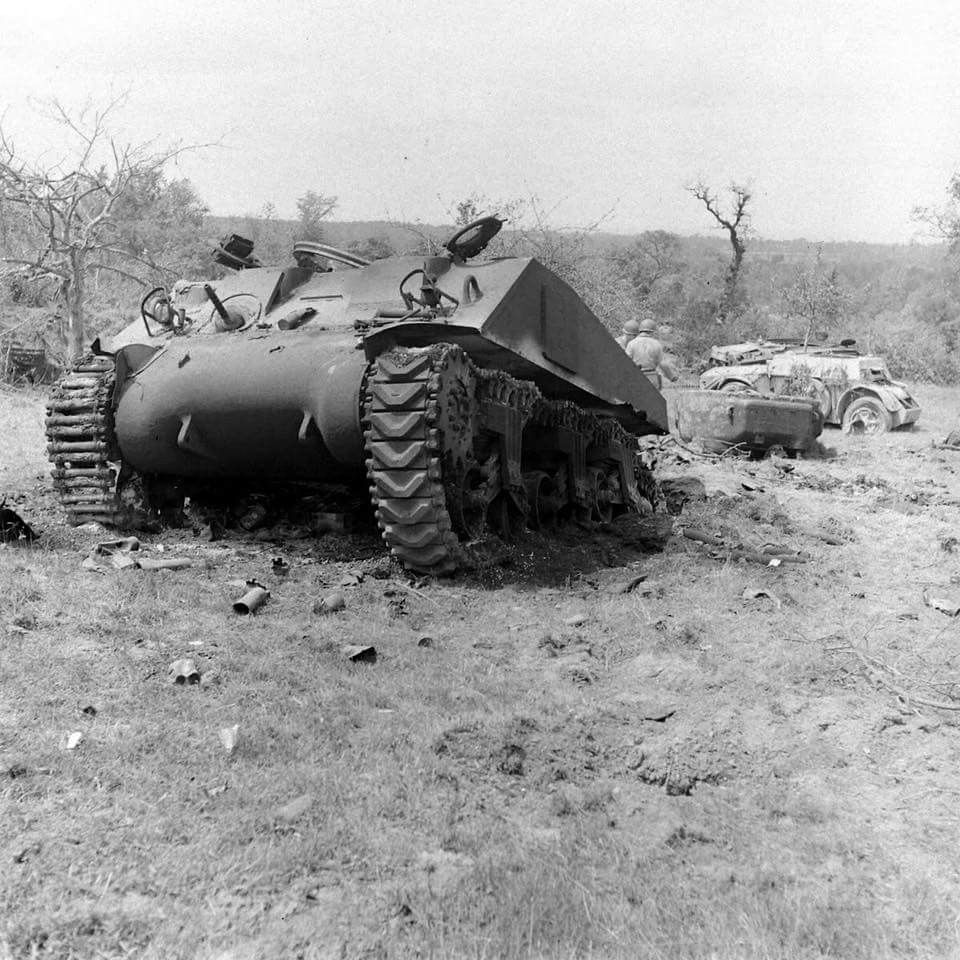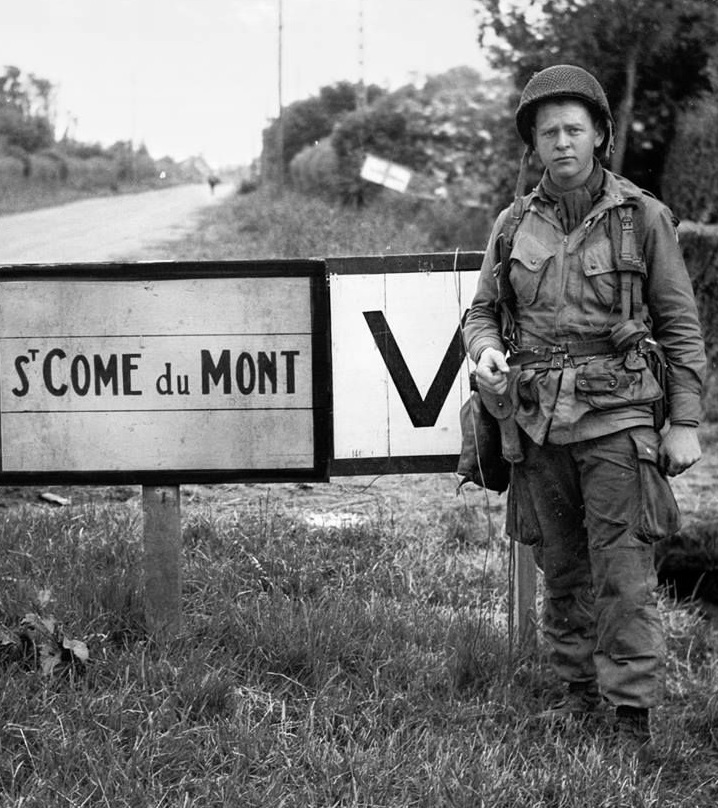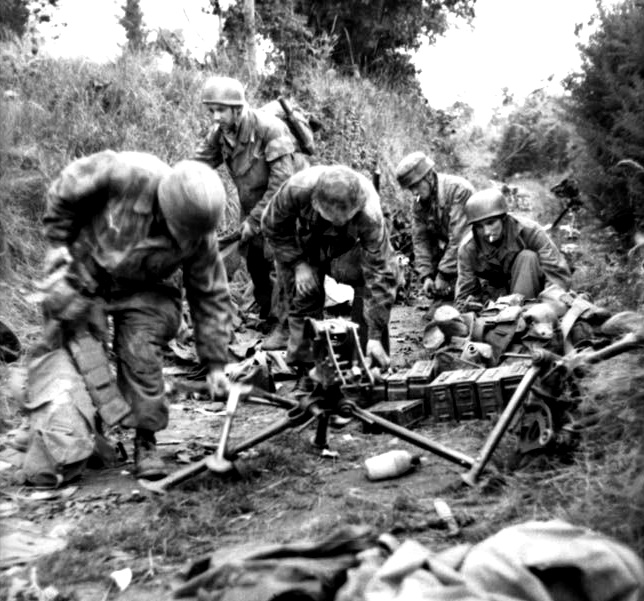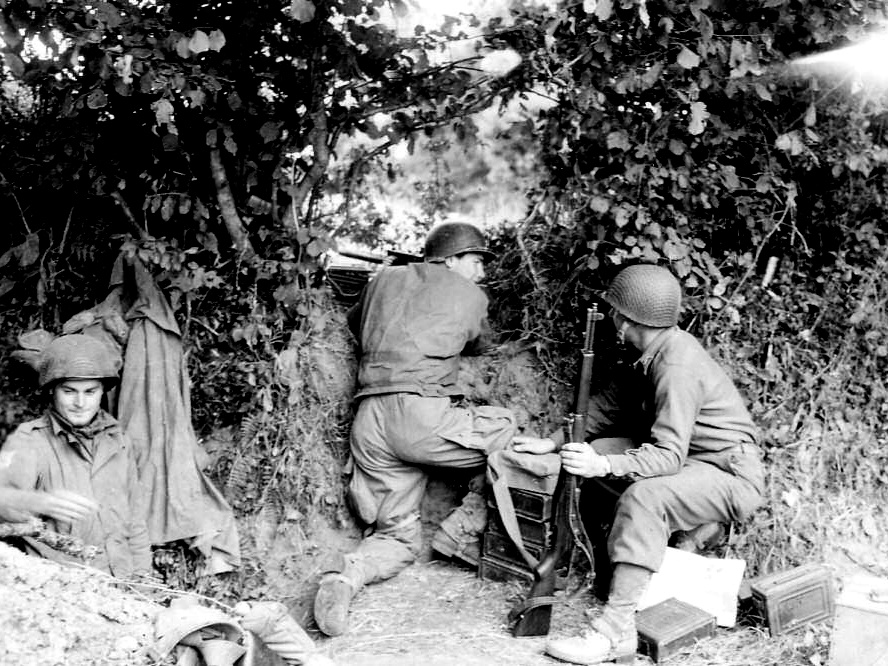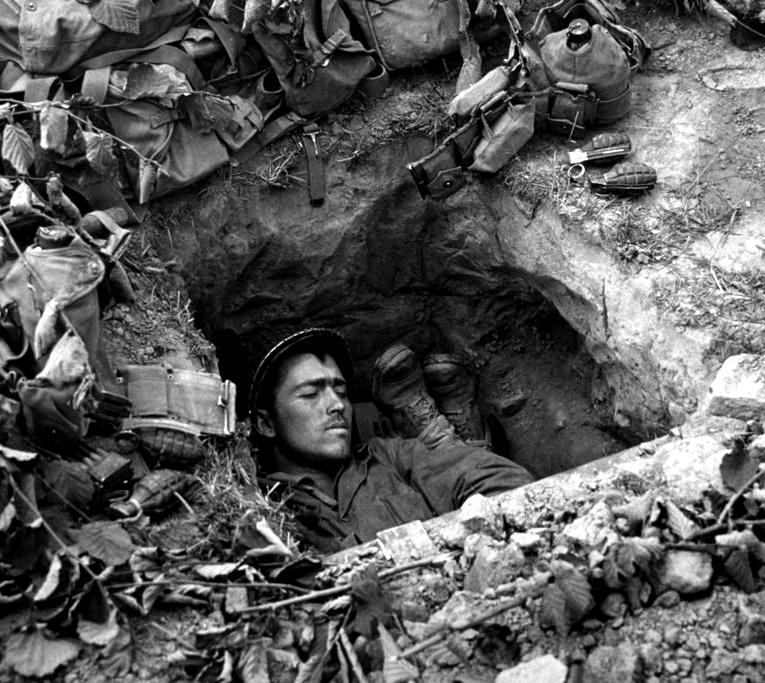Another tank was struck by a German rocket, and all the tanks withdrew to the crossroad where shortly after, on Col Sink’s order, they moved to Angoville au Plain to assist the 2/506 in clearing out that town. Baker Co continued to press toward the farm buildings on its right flank with little success. A 57-MM AT piece was brought forward and pushed through the hedgerows to bring direct fire to the farmhouse and the trench system, and Baker Co was then able to clear out this area. While Baker Co was mopping up, Charlie Co was committed to the attack with instructions to probe to the left and endeavor to locate and envelop the enemy flank, Charlie Co moved laterally along the road toward Angoville au Plain for about four hundred yards, then turned to the right, and, in a column of files with one squad one hedgerow out on each flank for security, made its first probe. This probe was successful only in determining that the enemy occupied the hedgerows here in as great strength as at Beaumont. Several machine guns brought fire on the company, and it retired to the road and attempted another probe further to the left.
This attack was just getting underway when the company was ordered back to Beaumont. Baker Co’s success in clearing out the farmyard was to be exploited, and it was planned to move the battalion through Baker Co’s sector and continue the drive toward the St Come du Mont crossroad. Before the plan was implemented, the enemy moved in again, occupied the farmyard, and brought fire on the troops at Beaumont. Two of the tanks rejoined the battalion, and once more Baker Co assaulted the farm buildings; this time met even stronger resistance; and after receiving more casualties, withdrew to Beaumont.
Dog Co Attached
 Col Sink, upon being informed of the situation, decided that more of a force was needed than the 1/506 could muster, and Dog Co was attached. Dog Co, consisting of more than ninety men and probably the largest company in the regiment, was attached to the 1/506 at 1630 and was ordered to assist Baker Co by fire from a position about four hundred yards to the north of the farm buildings. With this assistance, the two tanks and the 57-MM AT gun, Baker Co pushed the enemy back from the farm again. Charlie Co was then ordered to relieve Baker Co and hold the farm position until the battalion could move out of Beaumont. A heavy concentration of mortar fire was delivered on the crossroad during this relief, and additional casualties were incurred. By this time the troops were utterly fatigued. They had little or no sleep for more than fifty-two hours; they had experienced the emotional strain of a parachute jump; they had been continually active, either marching, fighting, patrolling, or sitting out the nights under most trying circumstances. They were losing confidence in their commander and his ability to get the battalion moving. They were bushed! They had almost ‘had it’.
Col Sink, upon being informed of the situation, decided that more of a force was needed than the 1/506 could muster, and Dog Co was attached. Dog Co, consisting of more than ninety men and probably the largest company in the regiment, was attached to the 1/506 at 1630 and was ordered to assist Baker Co by fire from a position about four hundred yards to the north of the farm buildings. With this assistance, the two tanks and the 57-MM AT gun, Baker Co pushed the enemy back from the farm again. Charlie Co was then ordered to relieve Baker Co and hold the farm position until the battalion could move out of Beaumont. A heavy concentration of mortar fire was delivered on the crossroad during this relief, and additional casualties were incurred. By this time the troops were utterly fatigued. They had little or no sleep for more than fifty-two hours; they had experienced the emotional strain of a parachute jump; they had been continually active, either marching, fighting, patrolling, or sitting out the nights under most trying circumstances. They were losing confidence in their commander and his ability to get the battalion moving. They were bushed! They had almost ‘had it’.
Night Attack
Dog Co was recalled from its position and ordered to move down the road immediately toward St Come du Mont. One tank was to be loaded with the wounded and was ordered to the Angoville au Plain aid station (at the Church). The other tank was ordered to support Charlie Co until the column had cleared the crossroad. Hqs, Able, Baker, and Charlie Cos were to follow the relatively fresh Dog Co in that order. At 2100, Dog moved out down the road which a few hours before had been so heavily defended. Its progress was so fast that the fatigued men of the battalion had difficulty keeping pace. Dog Co’s CO had been given the briefest orientation when he was ordered forward. Consequently, he and his men knew only that there were supposed to be friendly troops somewhere in the vicinity of the crossroad south of St Come du Mont, their objective. As they approached the crossroad east of St Come du Mont they put up orange flares, the signal of friendly troops. The flares brought down a blast of fire from both flanks, and Dog Co was halted, momentarily, in the ditches on both sides of the road.
The word was passed back down the column for the tank to come forward. It left the Beaumont crossroad in response to the message just as the last of Charlie Co was falling in on the road. Within a few minutes, another message was passed back, machine guns to the head of the column. All of the machine gun crews ran forward. While they were still running down the road, another message came back calling for the Rocket-Launchers (Bazookas) to come to the head of the column, and all of the rocket launcher crews double-timed toward the head of the column. It was nearly dark, and visibility was limited to the hedgerow nearest the flanks and to about ten yards to the front and rear. Upon arrival at the head of the column, the tank fired with good effect on the flanks and forced the Germans to keep down while the column regained its momentum and pushed ahead. All of Dog Co and most of the Hqs and Able Cos cleared the crossroad east of St Come du Mont without suffering casualties and continued toward the objective about seven hundred yards to the front. The Germans permitted this much of the column to pass, then, from positions north and east of St Come du Mont, brought heavy fire upon the column.
Severance of the Column
This was a little too much for the troops just about to start their third day of fighting without rest. The battalion commander, his S-3, and the company commanders of Hqs and Able Cos were with Dog Co to the front along with all of the machine guns and rocket launchers. Someone along the line passed the word, Pullback, and the tail of the column recoiled into Beaumont. The battalion adjutant, at the rear, directed the companies into assembly areas around the crossroad as they came in, and an effort was made to determine who had ordered the withdrawal. This point still remains in doubt. None of the officers would admit having originated the message, and not all of the men could be interviewed in the dark. It was the opinion of the most reliable observers that the enemy was too strong at the front to permit another attempt to rejoin the battalion until automatic weapons could be obtained.
Meanwhile, Dog Co, with the tank, had pushed on to the objective and occupied a strong defensive position prepared by the Germans. By midnight the forward elements of the battalion were well disposed to hold until morning. It was with considerable surprise that the battalion commander received, at 0015, a radio message to return to Beaumont. At 0030 the return was well underway, and at 0130 the battalion had closed in Beaumont. The tank had been knocked out by a German rocket on the objective, and the body of one of the tank crew was blown out of the tank into the ditch at the side of the road where it burned. The crossroad was subsequently referred to as Dead Man’s Corner to distinguish it from another crossroad, the one to the east of St Come du Mont.
When the rearmost element of the battalion had decided against attempting to join the forward part of the battalion, the senior officer present took a patrol and reported the situation to Col Sink in his CP at Angoville au Plain. He arrived a few minutes behind Gen Anthony McAuliffe, the Assistant Division Commander, who had brought news of new attachments. The belated battalion of the 401-GIR was attached again to the regiment, along with a battalion of the 501-PIR. Nearly two battalions of artillery and additional light tanks had been made available and were also attached. With such a strong force available for the attack on St Come du Mont and the bridges to the south, Col Sink did not believe it prudent to leave the 1/506 in its extended position, and he had promptly ordered it back to Beaumont. The order for the attack in the morning was given verbally, and generally, it called for the convergence of all the available battalion upon St Come du Mont and the highway extending south to the bridge over the Douve River, which was assigned to the 401-GIR for destruction.
The 501-PIR was assigned a sector on the right of the 401-GIR, and the 1/506 was given the extreme right sector. The 2/506 was to follow the 1/506 by bounds. The attack would be supported by tanks and artillery. The line of departure extended roughly northeast and southwest from a point on the road about four hundred yards south of Beaumont. The attack was to jump off at 0445, preceded by an elaborate artillery preparation. The two battalions of artillery were to fire a ten-minute preparation on suspected enemy strong points, including St Come du Mont, to be followed by a rolling barrage scheduled to advance one hundred yards every four minutes. The time left for the preparation of the attack was negligible. It permitted passing the orders to only battalion and company commanders and left very little time for orienting junior leaders on the situation and the mission. The battalion commander of the 501-PIR knew little of the general situation in the area and could make only a map study of the terrain. Time was of interest to the 1/506 as a period for sleep only. So fatigued were the troops that the company commanders had to physically kick the men awake and on their feet at a jump-off time. The gun crews and ammunition bearers, who had left their units the preceding night were sorted and put into their respective units en route to the line of departure. The battalion plan of attack envisaged that Able Co, followed by Charlie Co, would attack toward the east side of St Come du Mont on the battalion’s right, while Dog Co, which was still attached, would attack the left of Able Co, followed by Baker and HQs Cos.
The attack was launched on time, although there was still considerable confusion caused by men moving to their proper units. The artillery preparation was fired as planned and the troops followed it as close as one hundred yards. No enemy resistance was encountered and the attack progressed to the road leading east out of St Come du Mont. Along this road, the battalion halted and built up a line, and soon was brought under heavy mortar fire. Mortars could be heard firing from the southwest part of the town; either the fire was observed, or it had been previously registered for it was incredibly accurate. The zone of fire extended from the east edge of town, along the road, and past the crossroad, the crossroad receiving particularly heavy concentrations. From this point, the situation becomes obscure. Other historians have attempted to record the succeeding events with doubtful success. Col SLA Marshall, the historian of the European Theater, spent several days in June and July 1944 interviewing the available participants in the action. His record, which appears in a small unit study entitled, 506-PIR in Normandy Drop, is brief and somewhat misleading. His story alleges to relate the actions of battalions, whereas, in point of fact, the battalions had become so dispersed and intermingled that their identity was lost, and the history relates more accurately the movements of the battalion commanders and small elements of the battalions.
At the crossroad, the commanders of the 1/506 and the 1/501 met. This was their first contact, the attack order having been given to each individual, and their first opportunity to discuss boundaries, mutual support, and rate of progress. Both commanders were of the opinion that the crossroad south of St Come du Mont was the specific objective of their own battalion. Additionally, the 501-PIR was being pinched out, as the 1/506’s left flank lay on the road and the inundated area on the right was forcing the 401-GIR into the left of the 501.










